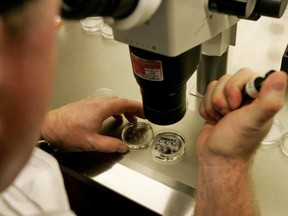Science
Scientists Transform Skin Cells into Fertilizable Eggs in Lab Breakthrough

In a groundbreaking achievement, a team of scientists has successfully converted human skin cells into fertilizable eggs and subsequently fertilized them with sperm in a laboratory setting. This development, announced on March 15, 2024, marks a significant advance in reproductive technology, potentially offering new options for individuals facing infertility.
The research, led by scientists from the Oregon Health & Science University in the United States, is still in its early stages. Although the technology, referred to as in-vitro gametogenesis (IVG), is not expected to become available for public use for at least another decade, experts believe it could fundamentally alter the landscape of infertility, which currently affects approximately one in six people globally.
Details of the Breakthrough
The scientists utilized a method known as somatic cell nuclear transfer, previously employed in the cloning of Dolly the sheep in 1996. They began by removing the nucleus from ordinary skin cells and transferring it into a donor egg from which the nucleus had also been removed. The challenge lay in the fact that skin cells contain 46 chromosomes, while eggs only contain 23. The researchers addressed this issue through a newly developed process called “mitomeiosis,” which simulates the natural division of cells.
As a result, the team was able to create 82 developing eggs, known as oocytes, which were then fertilized using in vitro fertilization (IVF). After a six-day period, less than 9 percent of the embryos reached the developmental stage suitable for transfer into a uterus. While this figure is low, it is noteworthy that only about one-third of embryos typically progress to the IVF-ready “blastocyst” stage during natural reproduction.
Paula Amato, a co-author of the study, expressed optimism about the potential implications of this research. She noted that IVG technology could pave the way for older women and those without viable eggs to have children genetically related to them. Furthermore, it could allow same-sex couples to have children who are biologically linked to both partners.
Future Implications and Ethical Considerations
While the current study demonstrates proof of concept, researchers acknowledge that significant challenges remain. Amato highlighted that the primary obstacle is achieving genetically normal eggs with the correct chromosomal composition. Other experts in the field, such as Ying Cheong from the University of Southampton in the United Kingdom, praised the breakthrough, emphasizing its potential to reshape understanding of infertility and miscarriage.
“For the first time, scientists have shown that DNA from ordinary body cells can be placed into an egg, activated, and made to halve its chromosomes,” Cheong stated. “While this is still very early laboratory work, in the future it could transform how we understand infertility and miscarriage.”
Alternative methods for creating eggs in the lab involve reprogramming skin cells into induced pluripotent stem cells, which can develop into any cell type, including eggs. Amato noted the need for further research to determine which approach will prove more successful. Regardless, she emphasized that both methods are still many years away from practical application.
The research team adhered to existing ethical guidelines in the United States concerning the use of embryos, ensuring that their work aligns with regulatory standards.
As this field continues to evolve, the implications of turning skin cells into eggs could offer hope to countless individuals and couples striving for parenthood, fundamentally altering the landscape of reproductive health.
-

 Politics4 weeks ago
Politics4 weeks agoSecwepemc First Nation Seeks Aboriginal Title Over Kamloops Area
-

 World5 months ago
World5 months agoScientists Unearth Ancient Antarctic Ice to Unlock Climate Secrets
-

 Entertainment5 months ago
Entertainment5 months agoTrump and McCormick to Announce $70 Billion Energy Investments
-

 Science5 months ago
Science5 months agoFour Astronauts Return to Earth After International Space Station Mission
-

 Lifestyle5 months ago
Lifestyle5 months agoTransLink Launches Food Truck Program to Boost Revenue in Vancouver
-

 Technology3 months ago
Technology3 months agoApple Notes Enhances Functionality with Markdown Support in macOS 26
-

 Lifestyle3 months ago
Lifestyle3 months agoManitoba’s Burger Champion Shines Again Amid Dining Innovations
-

 Top Stories2 months ago
Top Stories2 months agoUrgent Update: Fatal Crash on Highway 99 Claims Life of Pitt Meadows Man
-

 Politics4 months ago
Politics4 months agoUkrainian Tennis Star Elina Svitolina Faces Death Threats Online
-

 Sports5 months ago
Sports5 months agoSearch Underway for Missing Hunter Amid Hokkaido Bear Emergency
-

 Politics5 months ago
Politics5 months agoCarney Engages First Nations Leaders at Development Law Summit
-

 Technology5 months ago
Technology5 months agoFrosthaven Launches Early Access on July 31, 2025




















